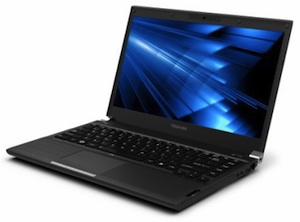Toshiba Rolls Out 3.1-Pound Education Notebooks

The 3.1-pound Toshiba Portégé R830 series comes equipped with USB 3.0 and supports wireless display at up to 1080p resolutions. |
Toshiba has rolled out two new series of notebooks for education, including a model that weighs in at 3.1 pounds and can be configured with an Intel Core i7-2620M processor.
The new Portégé R830 is a series of lightweight, 13.3-inch full-feature notebooks built around Intel's Core i3, i5, and i7 mobile chips. The base model includes a 2.1 GHz Core i3-2310M processor with 3 MB cache. That can be upgraded with a 2.7 GHz/3.4 GHz Core i7 2620M processor with 4 MB cache for $300 more. The Portégé R830 is about an inch thick and weighs 3.1 pounds. It also has an EPEAT Gold rating and includes Toshiba's Eco Utility for managing power.
Portégé R830 specs include:
- CPU Options: 2.1 GHz Intel Core i3-2310M with 3 MB cache; 2.5 GHz/3.2 GHz Intel Core i5-2520M with 3 MB cache; 2.7 GHz/3.4 GHz Intel Core i7 2620M with 4 MB cache
- Graphics: Integrated
- Display: 13.3-inch LED backlit display (1,366 x 768 resolution)
- Memory: 2 GB (expandable to 8 GB)
- Storage: 320 GB, 5,400 RPM SATA hard drive (upgradable to 500 GB, 7,200 RPM hard drive or up to 512 GB solid state SATA drive)
- Optical Media: DVD±R DL
- Networking: Gigabit Ethernet, 802.11a/g/n WiFi (upgradable to Bluetooth 3.0+EDR and Intel WiMax 4G)
- Peripheral and Display Ports: One 5 Gbps USB 3.0 port, one eSATA/USB 2.0 combo port with sleep and charge, one standard USB 2.0 port, memory card reader (Secure Digital, Secure Digital High Capacity, Mini SD Card, MultiMediaCard), HDMI, RGB (mini D-sub 15-pin)
- AV: Webcam and microphone, integrated stereo speakers, line in, headphone jack
- Battery: 6-Cell Li-ion battery pack (up to nine hours of battery life)
- Security: Lock slot
The Portégé R830 also includes support for streaming video wirelessly to an external display such as a television.
Toshiba has also expanded its Tecra line of education and business laptops with the launch of the R850 series, a 15.6-inch notebook that includes DisplayPort support and USB 3.0 connectivity. It weighs in at about 5.3 pounds and measures 14.9" (W) x 9.9” (D) x 1.19” (H).
Tecra R850 specs include:
- CPU Options: 2.5 GHz/3.2 GHz Intel Core i5-2520M with 3 MB cache; 2.7 GHz/3.4 GHz Intel Core i7 2620M with 4 MB cache
- Graphics: Integrated
- Display: 15.6-inch LED backlit display (1,366 x 768 resolution)
- Memory: 2 GB (expandable to 8 GB)
- Storage: 320 GB, 5,400 RPM SATA hard drive (upgradable to 500 GB, 7,200 RPM hard drive or up to 512 GB solid state SATA drive)
- Optical Media: DVD±R DL
- Networking: Gigabit Ethernet, 802.11a/g/n WiFi (upgradable to Bluetooth 3.0+EDR)
- Peripheral and Display Ports: One 5 Gbps USB 3.0 port, one eSATA/USB 2.0 combo port with sleep and charge, two standard USB 2.0 ports, memory card reader (Secure Digital, Secure Digital High Capacity, Mini SD Card, Micro SD Card, SDXC, Memory Stick, Memory Stick Pro, Memory Stick Pro Duo, MultiMediaCard), ExpressCard/34 slot (optional), DisplayPort, RGB (mini D-sub 15-pin)
- AV: Webcam and microphone (optional), integrated stereo speakers, line in, headphone jack
- Battery: 6-Cell Li-ion battery pack (up to seven hours with SSD)
- Security: Lock slot, fingerprint reader, smart card reader (optional)
Both of the new laptops come equipped with the Blio-based Toshiba Book Place eReader, tools for sharing media files via WiFi, and USB sleep and charge (for charging external devices via USB when the laptops are asleep).
Both of the new series of laptops are currently shipping. Prices for the new models vary widely by configuration. The Tecra R850 starts at $879. The lightweight Portégé R830 starts at $799.99 with a Core i5-2410M processor. Further details can be found on Toshiba's education portal.